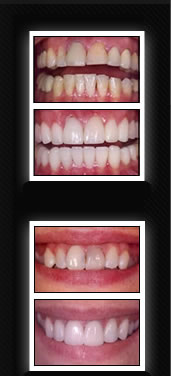Cosmetic Dentistry
Cosmetic dentistry is a combination of dental procedures that focus on enhancing a patient’s smile, while also maintaining the patient’s dental health and function of the teeth. Enhancing a smile often has a positive emotional and psychological impact on a patient’s life by improving the patient’s self-image.
Dental procedures and techniques used in cosmetic dentistry can include:
- Laser dentistry to fix "gummy" smiles - where a disproportionate amount of the gums show when smiling.
- Teeth bleaching and whitening to remove stains from teeth.
- Porcelain veneers and inlays to fix broken/cracked, mismatched teeth, or correct gaps between teeth.
- Dental implants and crowns to replace missing teeth.
- Use of tooth colored fillings to replace unsightly silver amalgam fillings.
- Use of non-metal crowns to replace old crowns that show black lines.
Dr. Da Cunha can create a customized cosmetic dental treatment plan that is perfect for your smile. Make an appointment for a consultation today!
back to top
Porcelain Veneers
A veneer is a thin shell that is bonded to a tooth to improve its color and shape. Veneers are a perfect solution for teeth that are chipped, discolored, or have an irregular appearance. The first step is to take impressions of each tooth, so the veneers can be made precisely. Next, the veneers are bonded to the teeth with a strong adhesive. Once in place, veneers are indistinguishable from a regular tooth in both appearance and function.
back to top
Crowns & Bridges
If you have a tooth that is discolored, badly shaped, weak or broken, a crown can be used to cover and restore it to its normal shape and size. Dr. Da Cunha can install a crown to cover a dental implant, a large filling or to attach a bridge.
Missing one or more teeth will have a negative effect on your appearance and your chewing and speaking abilities. Dr. Da Cunha can correct this problem through the use of a bridge, which will help maintain the shape of your face, as well as alleviate the stress in your bite. Bridges can be fabricated from various materials including gold, alloys, porcelain or a combination of these. Depending on the degree of support from the surrounding teeth, Dr. Da Cunha can recommend the type of bridge that is right for you. One type of bridge can be bonded onto other teeth; this bridge is called a fixed partial denture, which can only be removed by our dental office. Or you could be an ideal candidate for a removable bridge, which can be removed by the patient. Finally, if Dr. Da Cunha recommends an implant bridge for you, artificial teeth will be attached directly to your jaw or under the gum tissue.
back to top
Tooth Colored Fillings
Tooth colored fillings are the material of choice for more natural looking teeth. Composites are made of glass and resin, tooth colored fillings can be used to both fill and to repair tooth defects. They are often used on the front teeth where a natural appearance is important. They can be used on the back teeth as well, depending on the location and extent of the tooth decay. Ask Dr. Da Cunha if tooth colored fillings match your needs.
back to top
Dental Bonding
Dental bonding can be used for two purposes. Dental bonding can be used for cosmetic and restoration purpose to restore chipped, broken or decaying teeth, reshape or whiten your smile or fill in gaps between teeth. Dental bonding can also be used to affix or attach bridges, orthodontic appliances or fillings to teeth.
In cosmetic dentistry, the bonding procedure begins when a composite resin filling is first scooped onto the teeth. Dr. Da Cunha will sculpt, color and shape the composite filling. A high intensity light is then used to harden the material. Finally, the surface is finely polished to achieve a natural appearance that blends with the rest of your teeth and improves your smile.
back to top
Root Canal Treatment
The root canal is the hollow space in the center of the tooth containing the pulpy nerve tissue that provides the tooth with a sensory function – which the ability to feel hot and cold. There can be up to four root canals in a human tooth. When the root pulp is damaged from cavity decay or fractures, pain is usually the result due to the increase in blood flow and cellular activity of the tooth. Bacteria can enter and multiply in the tooth, causing the pulp to die. If the tooth is not treated, the pain will get worse and infection can spread, possibly resulting in an abscess.
Root canal therapy involves removing the decayed pulp and cleaning out the canal. Dr. Da Cunha will reshape the canal and insert medication to kill bacteria, if necessary. Once the dentist has determined that all infection has been cleared, Dr. Da Cunha will fill the root canal with gutta percha, which is a rubber-like material. The tooth is then permanently sealed with porcelain or a permanent crown. Complete root canal therapy can take between one to three sessions, depending upon the condition of the tooth.
back to top
General & Family Dentistry
At the dental practice on Dr. Da Cunha, we are dedicated to general and family dentistry. As a primary dental care provider, Dr. Da Cunha is responsible for the general diagnosis, treatment, management and overall coordination of services related to the oral health needs for patients of all ages. He is highly educated and trained on all dental procedures and can consult with you to determine the best course of treatment for your dental needs.
back to top
Teeth Whitening
Teeth whitening is a cosmetic dental procedure that bleaches the enamel to lighten and remove tooth discoloration and stains from teeth. Tooth discoloration can result from many factors, including: beverages that stain (such as coffee, teas, and colas), tobacco, trauma, tetracycline staining, excessive fluoride, and nerve degeneration.
Under the guidance of a dentist, teeth-bleaching is one of the most safest cosmetic procedures available today. Research and clinical studies show that under dentist supervision, whitening teeth with carbamide peroxide and/or hydrogen peroxide is safe for both teeth and gums. These whiteners usually come in a gel form and are applied by the use of a custom-fitted mouth guard.
back to top
Complete & Partial Dentures
A denture is an artificial set of removable teeth made from acrylic resin and sometimes metal. Dentures are custom made to replace missing teeth and adjacent tissues. Dentures can be either partial or complete. A partial denture fills in the spaces made by missing teeth and prevents the remaining teeth from shifting position in the jaw. A complete denture replaces all of the teeth.
There are two types of complete dentures:
Immediate Denture - an immediate denture is fitted onto the gums immediately after teeth are surgically removed. Since the gums have not had a chance to heal, adjustments may be necessary after several months when the gums have completely healed.
Conventional Denture - a conventional denture is fitted onto the gums after the gums have had a period of time to heal after surgery.
Because of the custom nature of dentures, a denture can take between two to five dental visits for a proper fit. First, the dentist takes an impression of the gums and a wax bite to determine the vertical dimensions and proper jaw position. The dentist may make a trial denture or “try-in” to make sure of the right shape and color as well as proper fit. Once the denture is placed, additional minor adjustments may also be needed.
back to top
Cerec 3D
CEREC 3D is short for Chairside Economical Restoration of Esthetic Ceramics. This dental procedure allows a dentist to economically restore damaged teeth in a single appointment, using a high-quality, durable ceramic material that matches the natural color of other teeth. Cerec 3D provides the ability to save as much original tooth structure as possible.
CEREC 3D uses CAD/CAM (Computer Aided Design/Computer Aided Manufacturing) technology, which incorporates a camera, a computer and milling machine in one instrument. First, the damaged tooth is prepared by painting a thin layer of reflective powder directly on the tooth's surface. The dentist then uses a special camera to take an optical impression of the damaged tooth. This optical impression is transferred to the computer and displayed on a color computer screen, where the dentist uses CAD technology to design the restoration. Then CAM takes over and automatically creates the restoration. Using a high-speed diamond bur and a disk, the CAM mills the restoration out of a solid block of ceramic material. Once completed, the dentist bonds the new restoration to the surface of the old tooth. The whole process takes approximately one hour.
back to top
|














